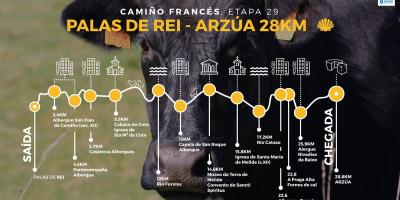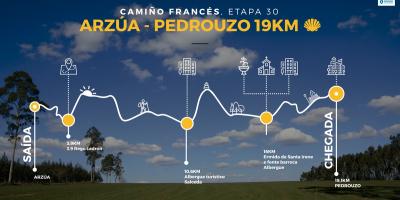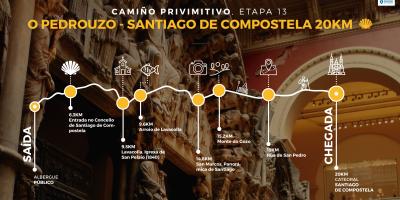It is said that the famous Codex Calixtino, an ancient medieval writing, is the first travel guide. It informed the pilgrims who traveled the Way about sanctuaries, towns and even dangers that could be found. In the Codex appears the French Way, the most popular of the different versions that are known.
The French Way is therefore the most popular of the different versions of the Way of Saint James, given the enormous historical weight of the origin linked to Medieval Europe. From the appearance of the tomb of the Apostle James, it was not long before this itinerary became known. In the places which it passes by, that historical character left impregnated a wide cultural, architectural and patrimonial footprint. That creates a very special atmosphere, which imbues us with different eras and, therefore, different artistic styles. Apart from that, the French Way is known for the beauty of the different natural spaces, something that of course is applicable also to its final stretches.
The road in the province
This road that departs from France, enters the province of A Coruña by Melide, and passes through Arzúa and O Pino before arriving in Santiago. These three towns, united by the pilgrimages, have in common an outstanding gastronomy, giving the pilgrim the opportunity to taste the conditions of inland Galicia. The melindre, a almond sweet of the land of Melide, the cheese of Arzúa and the Piñeiro cock from O Pino are protagonists of festivals of tourist interest with more than fifteen years of antiquity. Melide and Arzúa are the two major towns of theTerras do Ulla e o Tambre, and as can be seen from its name, highlighted by their rivers, which significantly shape the contour.
Already in Santiago de Compostela city, regardless of everything that involves the spectacular Obradoiro Square, civil constructions stand out such as the Pazo de Baamonde and the Casa de Cabildo, communing perfectly with the cobbled Compostela streets. Pilgrims can also see other attractions, always in harmony with the context, as the Galician Center of Contemporary Art Museum, designed by the acclaimed architect Álvaro Siza, attached to modernity and with an eye on the reality of the city. Beside it, stands the whole involving the Convent of Santo Domingo de Bonaval and the park of the same name, which happens to be an oasis of tranquility, views and recreation.
More information on The French Way, here
When entering the province of A Coruña in the parish of Furelos, we will have to cross the bridge of Furelos, a magnificent medieval bridge, one of the jewels of the Way civil architecture.
Melide is the town where Primitive Way meets the busiest French Way. In this locality you can visit the Ponte Leboreiro from the 14th century or medieval bridge from the 12th century. The churchs of San Martiño de Moldes, San Vicenzo de Vitriz, San Xoán de Furelos and the Pilgrims Hospital, now the Terra de Melide Museum, also highlight.
Already in Arzúa, we find the church of Santiago de Boente, and following the way we reach the Recreation Area of Ribadiso , with the pilgrims hostel that was an old medieval hospital.
After passing the town of Arzúa, in the village of Santa Irene we can see a chapel dedicated to the holy Portuguese martyr, built in the 18th century with the contributions of the nobles of the village of Dos Casas, and the fonte santa which has, according to tradition, healing properties for the skin.






